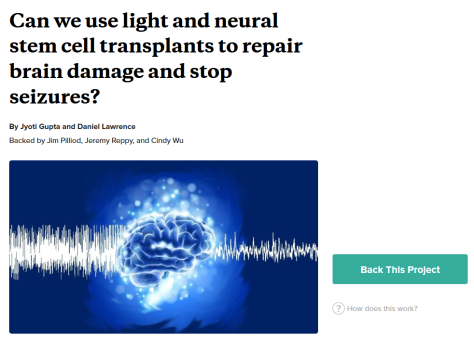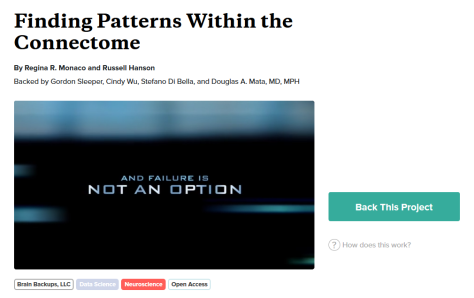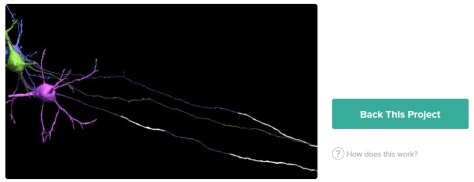The next project aims to fund the training of scientist to learn how to use light to affect neuron cells. Although this is not a research project by itself, training scientists always an improvement and in this case it will help the overall community of brain researchers.
Tag Archives: Brain
epow (Experiment project of the Week)
Understanding the brain is the big challenge of humanity, once achieved, it will represent a complete new paradigm for humans. Finding Patterns Within the Connectome.
epow (Experiment project of the Week)
The next experiment pledge aims to complete the understanding of how neurons survive in the brain. In particular, neuron cells need myelin in order to cover part of the axon with it. Myelin is fabricated by other cells in the brain. This study aims to study the myelin production and how it can be affected.
Analog: Science fiction and fact (March 2009)

Original title: Analog: Science fiction and fact (March 2009).
Title of this edition: Analog: Science fiction and fact (March 2009).
Author: David Bartell, Jerry Craven, Carl Frederick, Robert J. Sawyer.
Gender: Fantasy / Science Ficction.
Saga: Analog : Science fiction and fact.
Editorial: Orion Books.
Edition year: 1, 2009.
Prizes: …
Synopsis [Warning: Spoiler]: As the title suggest, this journal is composed of science fiction stories and facts. I will only write about the science fiction here.
Cavernauts (David Bartell): The exploration of the moon Callisto has lead to the discovery of one of the biggest caves in the solar system. Now it is the task of two cavernauts to go there and rescue the last patrol. While going deep into the cave, they discover that the cave is being drained trying to find diamonds.
After the first death (Jerry Craven): Something has happened to the exploratory patrol and now it is time for Clayborune to try finding them. Prosecuted by the native extraterrestrial race, Claybourne is forced to join them in a ritual. After the ritual, he discovers that what happens to the exploratory patrol was that they become trees. They reach a level of immortality, but sacrificing their conscience and ability to move. He has to escape, but because of the ritual, he is becoming a tree himself. In the end he manges to scape and discovers that it was all a worm that modifies the host to suit his necessities.
Lifespeed (Carl Frederick): A fencer and scientist discovers a substance that can accelerate the neural processes within the brain and hence make you react faster and as a consequence, is like the world moves slower. This allows him to be a better fencer, but at the cost of a boring life (everything just happens too slow).
Wake: Conclusion (Robert J. Sawyer): Caitlin is a blind girl with genius level at maths. Now, by using a experimental device, she is able to see again, but the device also enables her to “see” the web and to communicate with a conscience being that has arisen in the background of the net.
Personal Review: Before commenting about the individual stories, just to mention that this journal belongs to the BookCrossing initiative, so it will be back to where I pick it up and it will be available for more people to read it.
Cavernauts (David Bartell): I like this story for two reasons, the first one is that it doesn’t try to explain the difficult bits, like space engines or how to get to Callisto, and the other one is that it explains a lot about cave exploration. So, it is has a good balance that makes you enjoy it and feel like a real cavernaut (after all, if you are a cavernaut, you will probably know a lot about cave exploration and nothing about how spaceships works, which makes sense). It is nice also that the story includes references to internet and how everybody is connected 24h 7 days a week. However, it fails to anticipate some kind of cave mapping like for instance the one used in Prometheus.
Such kind of systems is currently being used in consoles and is becoming more and more popular, so it doesn’t require too much speculation to anticipate its use in a situation like the one described in the book.
After the first death (Jerry Craven): This books reminds me about old Sci-Fi movies, where a rocket is sent to unexplored territory with a team of brave people inside. What I’m trying to say, is that the “unexplored” situation is quite difficult to achieve. Before ever approaching another planets, it is expected to send probes, satellites and even robots. Later on, when it comes the time to face-to-face encounters (which might be very dangerous due to virus, chemical incompatibilities and even bacteria…), it will be only under very restrictive protocols. For instance, right now, despite we know there might be liquid water on Mars, the robots are not allowed to go find it, because they might carry earth micro-organisms that can contaminate that water.
Lifespeed (Carl Frederick): The brain main element is the neuron. Communication between neurons takes place through diffusion of chemical entities called neurotransmitters. Communication inside a single neuron takes place through an electrical pulse which is generated by change in ions concentration inside an ion channel. This two methods are not bad when executed a couple of times, but when they are repeated a thousand times, or when they require to travel a long distance, then they are extremely slow. That is the reason for the existence of myelin. Myelin covers part of the axon and basically speeds up the electrical pulses through the axon.
So, since this myelin cover in the axons is what affects more the speed of the signals, then it is not a bad idea trying to change it for another material that speeds up signals even more. This is quite complicated, and I’m not sure if there is anything else compatible with the est of the chemical reactions within the brain, but if there is another substance, then changing the myelin will need a gene therapy, since it is encoded in the genes what covers the axons. So, in principle, it might be possible, but extremely complicated. It will be something possible only through a massive team and collaborations between several groups, certainly not something a single scientist can do alone without anybody knowing what he is doing.
Wake: Conclusion (Robert J. Sawyer): This is only the last episode of a much bigger story, but is fine since there is a synopsis of what happened before. I would say that most of the blindness problems arise from lack of communication between the eye and the brain, hence more than needing a new eye, what is needed is an implant to close the gap. However, this is faster said than done, it requires to connect nerves to electronic devices, and that is not easy. On the other side, communication between an electrode and a nerve is being studied at the moment and we might by only a couple of years away from achieving it.
So, the eyePod part is ok… but sending the data back to Japan from United States will create such a big delay that the devices will not be functional (even with signals travelling at the speed of light it will add about 80 ms delay just fro travelling plus the time spent in the network nodes).

This problem with speed opens what might be the biggest problem with a conscious mind in the “back of the network”. This entity will be much more slower than a human (even if it is more intelligent). It is difficult to quantify how much slower, but it will take light about 120 ms to travel around the world. That is a significant part of a second, and it will take several signals to cross the world only for synchronization (which is an important part of how the brain works).
So, the eyePod part is ok, the conscience mind living in the network, despite being used quite a lot in novels… sounds quite impossible. At least as something that can think as we do or even faster. It could be more intelligent, but it will be slower.
Plushies 03 Giant microbes
Today I bring you new plushies… biological ones resembling virus, microbes and cells.
 Giant microbes is an online shop for those who love biology.
Giant microbes is an online shop for those who love biology.
 Some of them are quite unpractical, but for sure all of them are the perfect gift to learn about biology.
Some of them are quite unpractical, but for sure all of them are the perfect gift to learn about biology.
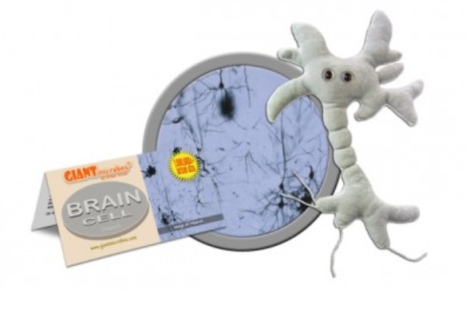 Also, if somebody has just recovered from that particular illness, they are perfect.
Also, if somebody has just recovered from that particular illness, they are perfect.
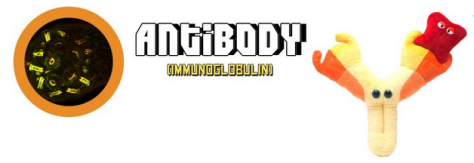 They can be a good way of making a boring class into something funny and help people learn.
They can be a good way of making a boring class into something funny and help people learn.
The selfish gene.

Original title: c
Title of this edition: The selfish gene.
Author: Richard Dawkins.
Gender: Divulgation.
Saga: —
Editorial: Oxford University Press.
Edition year: 1, 1989.
Prizes: …
Synopsis [Warning: Spoiler]: The gen is the basic entity in terms of evolution. When you think of evolution you need to think of the gen as a self-replicating structure that competes with other gens for the materials to replicate. The best ones will replicate, the worst… well, there is no second price. In this challenge the gens choose to cooperate, to be selfish and to build elaborate survival machines known as cells, tissues and bodies.
Personal Review: My field is physics, but I have some background in complex systems, and viewing this book from that perspective, this is a must read.
What is important here is that this book will go a little bit further than the “survival of the best fittest”. Allowing people with a good scientific level to reason into further details and general public to have access to a more updated view inside the field.
I think what the book does very well is turning the table and putting the gene and not the individual as the key element in the evolution game. This allows to go further into the implications of evolution and the book discusses a few examples quite interesting.
For those not willing to read it, this video tells more or less the key elements of the book.
Something that the book also introduces is the meme idea. Meme’s have been around since humans begun to create abstractions from the reality, but it is not until very recently that the idea of meme has hit the big public. As in the gene pool, there is a meme pool where meme’s compete for time in human brains, the more interesting (or funny), the more attraction and the best chances to survive longer time and pass from one mind to another (self-replicate). Chances to mutate or evolve may be different from meme to meme. For instance a Mozart’s composition is a meme that will not evolve quite fast, but still remain in many brains, while the internet memes change and mix together quite fast.
A quite interesting observation is that some memes cooperate together (as genes do). For instance, religion is a meme and celibacy is another meme. There is no reason for them to cooperate, but the fact is that if they do, there is more chances for them to survive. The idea here is that if monks practice celibacy, they will expend more time into the religion, making it possible for the religion to self-replicate.
Bear in mind that this is an essay and that some terms are quite vague, so it is easy to generalize them from one context to another. That doesn’t mean applying the ideas to a field will help making advances in the field. For instance, car shapes can be think as a meme that self-replicates and evolves. Since every new generation goes back to the designing table and starts from ideas that worked in the previous version… there is parallelism with evolution. But this doesn’t mean you will know how to design the new car. You know what you should not put on the car and that some features can be kept, but you will have no idea about how to proceed.
In resume, I encourage you to read it, because I learn quite a lot from it and I’m now willing to read its continuation, the extended phenotype.
3D effect on GIFS
It has been while since I saw 3D effect in GIFs, like the ones below made from stereoscopic images.

circa 1855)
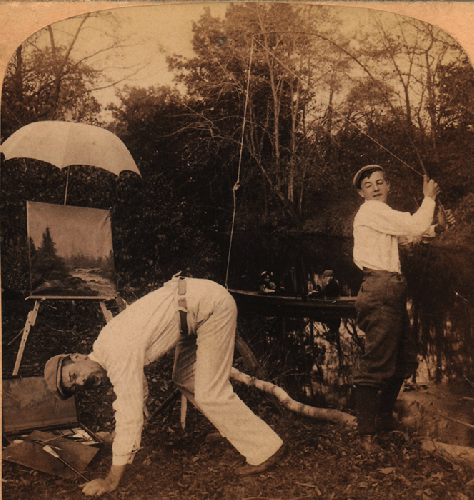
Strohmeyer & Wyman)

Strohmeyer & Wyman)
I think it is a nice trick and I have been wishing to reproduce it for a while.
It seems now it is as easy as downloading an APP called Google Camera
With this application you will take a picture and then pan the camera a little bit. This creates a special kind of picture that allow you to create the 3D effect.
To complete the effect and generate a GIF, you only need to load the picture into an online software called Depthy.
Nice and easy. Do you remember my Post about 3D with Catch? Here it is the same army but with this effect.
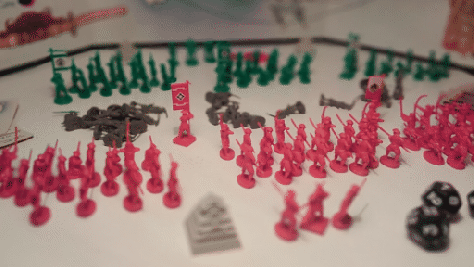
How to sequence the human genome
Why You Are Still Alive – The Immune System Explained
Paperscape

Paperscape is a tool to visualize papers in Arxiv (Arxiv is a free open archive for scientific papers and preprints), but not the information inside the papers, the relation between papers. Each paper is represented by a circle, and the size of the circle represent how many citations it has. To group together the papers they use an algorithm based on the common citations between papers.
So basically, is a tool to see what is going on in physics and what are the important things in your area.

Ok, let’s give it a try.
I’m going to look for Neural Network,s my old topic (hope to go back soon).
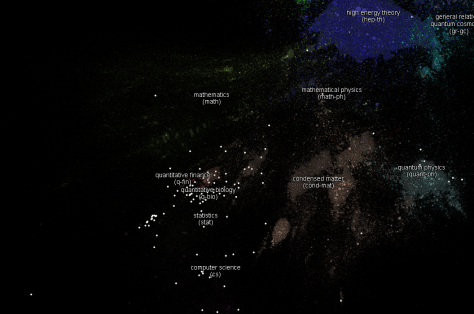
Nice, they lay close to quantitative biology.
And now my new topic, magnetic domain walls.
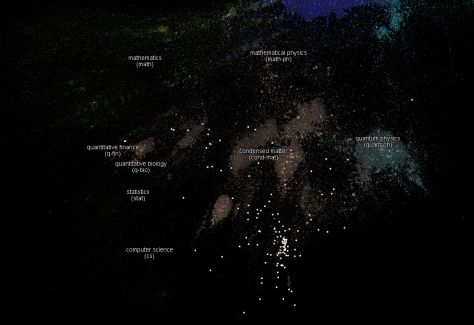
Not bad! Pretty close actually! And computer science is in between!
Hope you like it.
